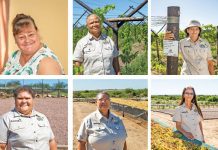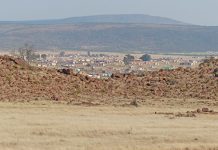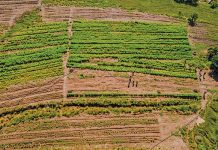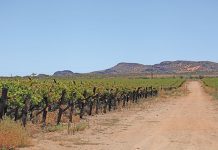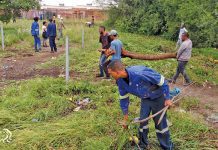’You’re either in, or you’re out!’ Glenneis Erasmus reports on the Hex River Valley farmers and farmworkers who are ’in’ and making transformation work. It all started with a small, yet significant competition searching for the best farmworker in the region. Now, this region is showing the rest of the agricultural industry how to truly empower and nurture healthy employer-employee relationships.
THE WESTERN CAPE MINISTER OF Agriculture Cobus Dowry has hailed Hex River Valley producers for their empowerment efforts in their community. “The Hex River Valley producers, in the way they continuously seek to empower their workers and community, are setting the standard for the rest of the agricultural industry,” was how Dowry praised them at the launch of various BEE projects in the region towards the end of 2006.
Despite growing concern over alleged incidents of deteriorating relationships between farmers and farmworkers, especially in the Western Cape, it seems as if the Hex River Valley has stumbled upon the secret of how to build healthy relationships between the two groups.
“We see our workers as one of the most important contributors to farming success,” says Boetie Kriel, project coordinator of the Hex Valley Table Grape Association (HTA). ”Many people used to look down on farmworkers. But we have tried to promote the image of farmworkers to instil a sense of pride and job satisfaction by clearly communicating their importance – not only for the profitability of the farm where they work, but for generating revenue in rural areas and creating job opportunities for other role-players in the industry.”
One of the main ways in which the region promotes the image and communicates the importance of farmworkers is through the Farm Worker of the Year Competition. It was initiated in 2002 when Sanlam approached Elza Jordaan, executive chairperson of the HTA to organise a Farmer of the Year competition for the region. But Jordaan had a better idea. She argued there were enough farmer competitions, and a competition acknowledging the importance of farmworkers would be a much better idea.
As a result, the Hex River Valley Farm Worker of the Year competition – the first in South Africa to acknowledge the importance of farmworkers – was born in 2002. The competition has grown from only 36 candidates from six farms in the Hex River Valley in 2002 to 126 candidates from 42 farms in 2006. The first provincial competition was held in 2005 – four areas entered – and the second was held in 2006, when six areas entered. The first national competition is now being planned.
Not just about money
“The rewards for the farmworkers amount to much more than the monetary value of their prizes. The competition has helped to build self-esteem and provide workers with a deeper sense of self-worth,” recalls Anthonie Visagie, winner of the 2005 provincial competition.
”As a result, farmworkers have more pride and work satisfaction. The relationship between farmers and farmworkers has also improved because farmworkers now know these two groups are interdependent for success in the agricultural industry.”
Albertus Mentoor, a regional winner in the Berg River Valley, says the competition has provided workers with an opportunity to measure themselves against other workers. “It has given us a platform, a goal and an opportunity to change people’s perception of farmworkers. It has created a buzz of excitement and ambition in our areas,” he explains proudly.
Empowerment in all forms
In the meantime, Jordaan has decided to take the next step towards true empowerment by handing over the competition to farmworkers. Previous winners will form a committee which will be responsible for the organisation and judging of the competition.
“Through ownership, workers can restructure and adapt the competition to better suit their needs and they can take responsibility for the future of the competition. Ownership will also inspire previous winners to plough back into the community what they have gained through the competition,” Jordaan explains. Numerous farmers in the region are empowering their workers by helping them to obtain land. These projects usually consists of a partnership between a farmer and his workers.
For example, Pieter Naude of Denau Boerdery has established the Denau Workers’ Trust consisting of 118 beneficiaries. The parties had formed a company in 2005 and bought the farm Kleinstraat, situated between De Doorns and Touws River. The company produces export table grapes – 24ha of the farm is currently under nets and it aims to expand production to another 50ha under nets within the next four years.
Another example is De Villiers Graaff who in 2005 bought the farm De Hoop to empower 213 of his workers. The farm grows 35ha of table grapes. The project is fully operational and a directorate, representing the trust and Graaff, is responsible for business management. The shareholders receive constant training and feedback with regard to the project.
Apart from the farmers in the area who practise empowerment, De Doorns Wine Cellar has provided 1,8ha of its land to nine workers. These workers have established a Columbar vineyard and the grapes are sold to the Wine Cellar.
One of the main benefits of these projects is that the workers, via their relationships with farmers, have gained access to established markets. Farmers provide guidance, mentorship, and a network of experts in finance, irrigation and nutrition that provide assistance.
At the BEE launch, Dowry encouraged workers to utilise the networks and benefits from the partnerships, as many new farmers find themselves lost and unfamiliar with whom to consult when they need advice.
Many sceptics have been critical of these projects, saying such large groups of beneficiaries will not make a living off these projects. Kriel argues that the projects should be seen as long-term investments for the workers – almost like a pension fund and not a get-rich-quick scheme.
“Shareholders continue to work on the farms where they are employed and if they work on farms that belong to a partnership they receive a wage that is comparable to that of people who work on other farms in the region. Shareholders, as a result, are not financially dependent on the projects,” he explains.
Kriel adds that the high costs of farming in the Hex River Valley renders empowerment through land financially unviable if beneficiaries don’t have substantial capital or an alternative source of income.
“An average farm in the Hex River Valley that consists of 24ha of table grapes will generate around 80 000 cartons of grapes per year, which are sold at around R30/carton. This translates into a turnover of R2,4 million. Prices attained in 2005 were, however, much lower due to the strength of the rand against major export currencies and farmers only attained R23/carton translating into an income of only R1,84 million.”
Kriel explains further, “Buying a farm with this production potential will cost more than R6 million in the Hex River Valley, resulting in debt that is three times more than the farm turnover. If 30 people pooled their LRAD funds of R100 000 each and received Casp money of R600 000, they would still owe R2,4 million.
”It would be near impossible for this group to farm at a profit and even more difficult for each of them to make a living from the farm,” Kriel advises.
Training and health services
The region has acknowledged that there are other ways to empower the community, besides through land. Many farmers are making use of government training schemes by sending their workers on courses. These vary from financial management and lifeskills training to production-related courses. Many farmers, in addition to providing kindergartens at farms, also employ healthworkers to address social and health needs of workers and their families. “These efforts have instilled a sense of pride and build the self-esteem of people in the region. This feeling of worthiness and independence has greatly contributed to a healthy relationship between farmers and community members,” Jordaan says.
’You’re either in, or you’re out.’
The Hex River Valley has an unwritten policy. “Nobody is forcing anybody to practise empowerment. It is totally voluntary. You’re either in, or you’re out. Farmers who are in, nevertheless, must be fully committed as the success of agricultural empowerment is imperative for the future of the whole agricultural industry. Farmers that are out should not criticise the process, as this damages the industry and the morale of those who are trying to make transformation work,” warns Kriel.
Water scarcity is one of the factors that restrains empowerment in the Hex River Valley. Therefore, farmers have proposed building a new dam in the area. An application for the dam was submitted more than three years ago, but to date has not been approved by the Department of Water Affairs and Forestry. In the meantime tenders and evaluations have expired.
Tired of waiting for approval, frustrated farmers decided to build the Osplaas Dam themselves. The dam is expected to be completed in June this year. “We would have had to stop some of our empowerment projects if the dam was not built,” Kriel explains.
Another constraint is the time it takes for LRAD funds from the Department of Agriculture to be allocated once an empowerment project has been approved. According to Kriel it takes at least one year before beneficiaries receive these funds once a project have been approved. |FW


